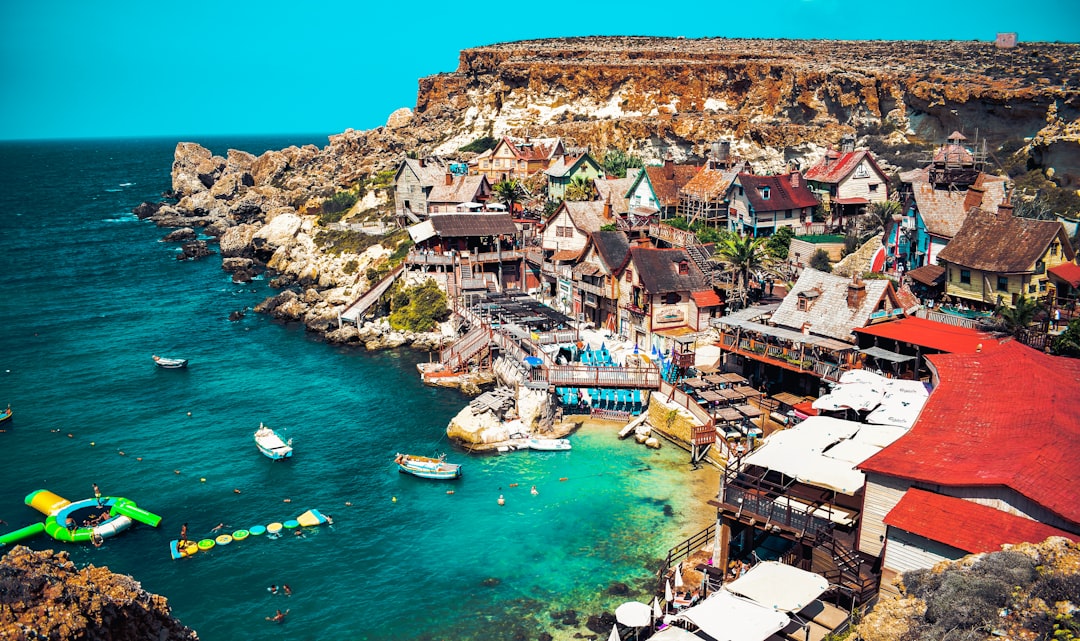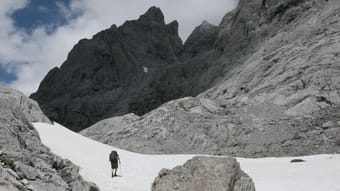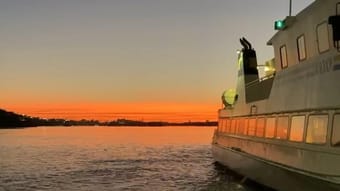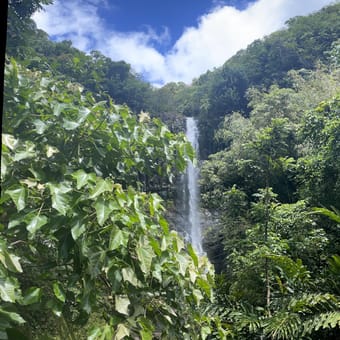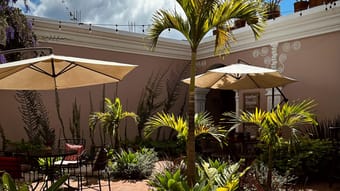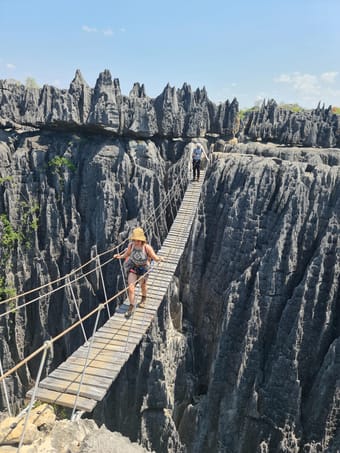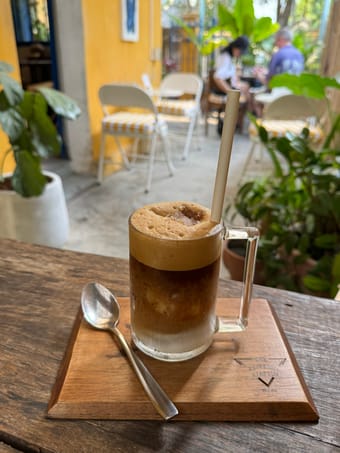Results for Taki
Delve into the enchanting charm of Prague with this curated guide, highlighting the city’s rich architectural and historical heritage. Experience the city’s captivating blend of Gothic, Baroque, and Renaissance styles through its iconic landmarks and historic sites. Stroll through picturesque squares, ancient churches, and grand palaces, each telling a story of Prague’s past.
Enjoy the vibrant atmosphere of cultural and artistic venues, from bustling markets to serene parks. Whether you're exploring medieval streets, admiring stunning viewpoints, or indulging in local cuisine, Prague offers a captivating mix of history, beauty, and modern charm.
This can be done in one day but I do suggest taking two. I've also added some cool bonus bars / resta
Adventure • Architecture • Art • Design • People & Culture
Free
4
We visited Malta in September 2022 and it was honestly one of the best places we’ve been in Europe. I’d highly recommend taking a trip to this island if you are looking for an equal mix of beach break and sight seeing in the city.
In this guide, I’ll take you through the full detailed itinerary of our trip, including 5 full days of activities and 2 travel days
(1 week in total)
Itinerary overview:
Arrival day: Travel day (we arrived in Malta late at night)
Day 1: Exploring St Paul's Bay
Day 2: Sight seeing in Valetta
Day 3: Café Del Mar beach club
Day 4: Boat trip to the Blue Lagoon
Day 5: Rooftop pool & Taza sky bar
Day 6: Travel home :(
This guide includes hotel recommendations, places to eat and drink, sight seeing tours, landmarks to visit, transportation details and more.
Adventure • Architecture • Art • Foodie • History • People & Culture • Romantic • Coffee • Beach • Relaxation
Free
4
Seven-day trek based in refugios.
INTRODUCTION
The Picos de Europa is a region of limestone peaks reaching over 2500 metres above sea level; the highest being Torre de Cerredo at 2650 metres. The route described here is one that I hiked alone in early summer. The best time to tackle the route is between June and September. There is more likely to be snow on the high passes in early June but they are usually not to difficult to negotiate.
The Picos de Europa is not as well known as the Pyrenees or Alps and as such the hiker traffic is less and the tourist infrastructure is less developed. This makes the area feel less spoilt but it can also make it a more challenging area to explore with fewer trails and little to no signposting. Always take a map with you: the Editorial Alpina 1:25,000 maps are the best. I took these and also used the outdooractive app and downloaded the relevant map tiles. This is useful for pinpointing where you are, in what can be confusing terrain. I was lucky to have clear weather for my entire trek but I would imagine that it's pretty difficult to navigate when the cloud is down on the mountains so take a compass too.
You can stay in refugios every night on this hike and wild camping is permitted above 1500m; details below.
I can't recommend the Picos de Europa as a hiking destination enough. The mountains are magnificent but there are also beautiful extensive woodlands at lower altitudes, as well as meadows full of wildflowers and butterflies. The juxtaposition between the stark limestone peaks and the gentle greenery of the valleys is beguiling.
DISCLAIMER: Please note that hiking in the Picos de Europa is not risk free. It is a very challenging area in which to hike. I accept no responsibility for any accidents you may experience while hiking this route. You are responsible for your own safety. Some of the dangers and difficulties are listed a little further down this guide.
HOW BUSY?
Unlike some of the more well know hikes around Europe this trail is less well trodden and as such the trail can be quite hard to follow at times, and at other times there is no trail! Despite this, refugios, being small, fill up fast (see below).
REFUGIOS
The hike is made easier if you stay in the staffed refugios where you can recharge your metaphorical batteries. Accommodation at these mountain huts is in communal dormitories and you will need to bring your own sleeping bag. It's best to book ahead as they are often full throughout the summer. Prices are around the €12-17 mark and they also do affordable meals (breakfast, picnic lunch and dinner).
There is also a handful of unstaffed, very basic mountain shelters with no services and no beds but these can be a good option in an emergency. Most of the refugios only accept cash so be sure to take plenty with you before you set off as there are no ATMs! All the refugios on the route are listed in the route description below with website links.
WILD CAMPING
Camping is only permitted at 1500m above sea level or higher. There is not much water anywhere above this altitude so be sure to fill up when you get the chance (at refugios) before camping in a remote spot.
POSADA DE VALDEON
This beautiful village tucked in the valley between the Macizo Central and Macizo Occidental is a lovely place to wander for a few hours. At the centre of the village there are a number of restaurants and bars and a small square with a water fountain. If you need somewhere to stay before or after the trek you'll find hotels, guest houses and a youth hostel. There is a hotel recommendation and link in the route description.
In the centre of the village is a pharmacy should you need any blister plasters! And on the road to the west of the village is the National Park office where you can find information about hiking and anything else to do with the national park.
GETTING THERE
From the UK there are Ryanair flights to Oviedo (Asturias airport) from London Stansted. A bit further afield you can get flights to Bilbao and Santander from the UK and the rest of Europe. Getting from the airport is a little complicated but there are buses to Posada de Valdeón from Oviedo changing in Cangas de Onis. The journey takes about 4.5hrs. There are also buses from Santander and Bilbao changing in Llanes and Riaño with the journey taking around 15hrs from Bilbao.
An easier but more expensive option is to get a taxi. You could also hire a car but of course you will have to leave the car sitting idle in Posada de Valdeón while you do the hike.
FLORA & FAUNA
This area of northern Spain is fantastic for wildlife. At lower elevations the beech and sessile oak woodland stretches for miles over rolling hills. This is part of the boreal forest that once would have covered much of Europe and is home to roe deer, wild boar, red squirrels, pine martens and brown bears.
In the skies you have a good chance of seeing griffon vultures, golden, booted and short-toed eagles, black kites and peregrines. Of the smaller passerine species the Picos are home to red-backed shrikes, black redstarts, spotted flycatchers and black woodpeckers.
But it's the wildflowers in the meadows and on the woodland edges that are the real joy and most easily appreciated. Vetches, cinquefoils and orchids create a colourful patchwork of colours with butterflies bringing the whole scene to life. Look out for swallowtails, fritillaries and hairstreaks.
NAVIGATION
Navigation is difficult as the terrain can be confusing and in many places there is no trail whatsoever. Take a map (1:25K Editiorial Alpina maps are the best), compass and GPS and know how to use them. It's also a good idea to download the map on a relevant map app. I used the outdooractive app but others are available.
WEATHER
Thunderstorms are common, usually in the afternoon and these can be particularly dangerous high up in the mountains. It's best to hike early and get to a refugio by lunchtime if there are afternoon thunderstorms in the forecast. The weather in this part of Spain is very changeable as it has a maritime climate. Rain and thick fog are possible but equally long periods of warm sunshine are not unusual. The best advice I can offer is to be prepared for anything. Pack suncream and a sunhat but don't forget your waterproofs either.
FALLING ROCKS
Rock falls are not unusual as chamois and other hikers can dislodge rocks above you. Getting caught in a rockfall is not so common but not impossible. Be aware and if you see rocks heading your way, and cannot find cover, crouch down on the floor and pull your rucksack over your head and back.
DRINKING WATER
There is very little running water as these mountains are mostly comprised of permeable limestone. You will need to take plenty of water with you each day (I packed three litres every day and usually drank it all). You can fill up at the refugios and there are a few fountains / fuentes although most of the ones I saw marked on the Editorial Alpina map were dry when I found them.
THE SUN
Sunburn and sunstroke are both real dangers and there is little shade. Keep hydrated and wear a sun hat that covers your neck.
TERRAIN
In some places you need to scramble up steep rocky sections. You will need to have experience in this kind of terrain and have a head for heights! The terrain is very rocky and uneven at higher altitudes so you will need strong, sturdy footwear. Trekking poles are also invaluable in providing support and helping you across and up awkward sections. There is also a lot of steep ascent and descent on this route so you will need to be reasonably fit.
DANGEROUS ANIMALS
On many parts of the trail you will encounter cows. In my experience they are very docile and used to trekkers so they shouldn't be of any concern. You may also find flocks of sheep and while these aren't dangerous they are often accompanied by shepherd dogs which have been trained to keep intruders away from the flock. They can be quite intimidating when they start barking at you. If you see sheep ahead it is best to give them a wide berth, even if this means veering away from the trail for a while. If you walk directly towards or through a flock of sheep you risk agitating the shepherd dogs.
Bears are not common in the Picos de Europa but there are bears in other parts of the Cantabrian Mountains, notably Somiedo National Park, not far to the west, and there is always the possibility of seeing an itinerant bear wandering through the Picos. Eurasian brown bears are not as big nor aggressive as the grizzly bears of North America so you shouldn't worry too much about an encounter. It's extremely unlikely you will see one so if you do, consider yourself very lucky.
Wild boar are common in the woodlands at lower altitudes. They are not as aggressive as some people will tell you and tend to be nocturnal. I did see some in the daytime near Vegabaño. As soon as they saw me they ran away, crashing through the undergrowth. As with any large animal it's best to simply give them plenty of space to move away from you.
I hope none of this advice puts you off hiking in the Picos de Europa. Yes, it's a challenging mountain area but the rewards for hiking here are great. Enjoy the hike!
Adventure • Nature • Slow Travel • Sustainable/Eco • Mountain • Camping
$12.00
3
Paris is a city filled with a rich history and culture, and one of the best ways to experience this is through its museums. While the Louvre is undoubtedly one of the most famous museums in the world, Paris has so many other fascinating museums that are often overlooked. After taking countless visitors to the Louvre while living in Paris, I began compiling my list of the best lesser-known museums in Paris that are definitely worth exploring. These are the fan favorites!
50+ • Family • Groups • Couples • Female Solo • Plus Size • LGBTQ+ • Car-free • Art • Architecture • History • People & Culture
Free
3
One of the best activities in Southeast Asia, taking a motorbike tour of the Ha Giang Loop is a must-add item to any avid traveler's bucket list. Full of adventure, incredible views, and new friends, this tour is an absolute gem.
Backpacker • Digital Nomads • Groups • Female Solo • Adventure • Outdoors • People & Culture • Road Trip
Free
3
The North Coast 500 is the magical route around the Highlands of Scotland.
This journey begins in Inverness, known as the gateway to the Highlands. We will drive to the West coast of Scotland, with the opportunity to include the Isle of Skye if you have some extra time. Then, we drive clockwise along the coast, taking in waterfalls, lochs, beaches, and the rolling hills of Scotland.
While driving the NC500, you will see the highlights of the route, with many opportunities for hikes, walks along the beach, and castles. As you drive you will be presented with scenic vistas of the rugged Scottish Highlands, whose views are known worldwide and are the real reason this route is so popular. You are encouraged to stop often at scenic points along the way to fully appreciate your surroundings.
This guide will include a full itinerary for an 11 day trip. It can be cut down to 9 days if you remove the Isle of Skye. If you don't do all the activities, you could potentially cut down some more time, but I have tried to limit driving to under 3 hours a day. This guide also includes suggestions on where to stay and where to eat dinner for each night of the trip.
Estimated budget of this trip based on 2 people sharing a room:
Accommodation (usually including a full breakfast) at an average £130 a night = £1,300
Dinner at an average £40 pp = £800
Car rental c. £40 per day = £440
Fuel for c. 830 miles at 148.5p = £1,235
Other (entry prices, parking) = £200
Total = £3,975
The food budget in particular in subject to where you go and what you order. This also doesn't include prices for lunch. Accommodation prices could also be reduced by staying in hostels rather than hotels/ B&Bs. Car rental prices were found on Kayak comparable site - these are variable.
Adventure • Road Trip • Beach • Mountain • Nature
$30.00
2
My fiancée excitedly asked if we could take a day trip to Sweden when we were in Copenhagen. I rolled my eyes thinking: what is there in Malmö that is so worth sacrificing a day in one of Europe's most incredible cities? But alas, happy wife happy life: we visited Sweden.
During our visit I was incredibly surprised at the breadth of activities and experiences to be had in Southern Sweden's Skåne region. Despite being culturally similar to Denmark, it really does feel like a different country: more modern, more ethnic diversity, more Dutch renaissance style architecture, even more coffee and pastries (fika is a Swedish concept after all!). If you are taking a weeklong trip to Copenhagen, spending a day in Sweden is a great way to experience something a bit out of the way and even less touristy.
This guide focuses on three great places to visit in Skåne: Lund, Malmö, and Helsingborg. You could easily combine two of these into one day trip, especially if you are looking for a full day of activities. I've also included a hotel recommendation in each city, just in case you want to extend your Swedish sojourn!
Art • Boutique • Budget • Coffee • Foodie • History
Free
2
🌟 Suwon Day Trip Delight 🌟
Taking a day trip to Suwon from Seoul? Here are some things that you can do in Suwon 🏞️
Experience the best of Suwon in just one day! From the majestic Hwaseong Fortress to the charming streets of Hanok Village, immerse yourself in South Korea's rich history and culture. Enjoy the delicious local cuisine, explore hidden gems, and create unforgettable memories.
I've also tracked down the spots where our favourite K-Dramas were filmed! So grab your camera to explore these spots. Get ready for a day filled with unforgettable memories and enchanting discoveries! 💖🏰🎥
Couples • Female Solo • Backpacker • Adventure • Architecture • History • People & Culture • Photography • Budget • Outdoors • Slow Travel
Free
2
I've compiled free activities to do in Barcelona for every day of the week. There are plenty of events during the weekend as Barcelona is a lively city so I would also check for any activities taking place the weekend you decide to go. Keep in mind that most museums are free for entry on the first Sunday of each month and this applies to most museums across Europe.
Female Solo • Family • Backpacker • Couples • Digital Nomads • Groups • Adventure • Architecture • Art • Budget • History • Outdoors • People & Culture • Photography • Relaxation • Slow Travel
$5.00
2
If you're a nature lover visiting the city of Stockholm, you can enjoy the best of both worlds by staying at a waterfront hotel, surrounded by nature. And you can even take the ferry there, if you know where to stay!
I love taking the ferry from the inner city -- home, and to the archipelago beyond. So I've made a guide with a few hotels along the inlet to Stockholm, if you also want to treat yourself.
I've chosen hotels and B & B/hostels with gorgeous water views -- easily accessible by ferry* -- along the inlet to Stockholm.
We start on a hostel ship in the very heart of Stockholm, across the pond from the Royal Castle, and end at a hotel on a small islet that's actually an old military fort.
Because I live near Stockholm's inlet, myself, I've not needed to stay at hotels, but I've chosen stays in naturally beautiful locations that I like to visit myself, and where I know the docks* well. If you find the guide helpful, and book through my links here, I may get a commission from the sale (at no extra cost to you).
*Ferry traffic and boat type may vary depending on season, and docks/jetties. So it's important to check boat availability and time tables (with the hotels, transport cos.) ahead of time.
If you'd like some more visual inspiration from on and off the water, come along for a virtual boat ride on my Instagram account!
I'd also be happy to create a custom guide with travel recommendations for you. You'll find the link in my bio.
Excited for your trip to Stockholm, where you can hail a... ferry! :-)
Nature • Boutique • Budget • Luxury
Free
2
This is a comprehensive guide with viewpoints, pit stops, and parking recommendation for your journey to Hana. It's definitely not as scary as people make it seem, and worth renting a car and driving by the coast yourself to take the necessary time. This guide follow Highway 360, so you are not taking the "backway".
It is ideal to take at least 2 to 3 days to see and hike everything along the way. The guide is organized by by the route, with more details on Hana, Wainapanapa and Kipahulu.
This guide includes: mapped stops along Road to Hana, hotel recommendations, food recommendations, activities and hiking recommendations, and reservations links.
If you have any questions, please feel free to message!
Last visited: May 2023
Adventure • Nature • Road Trip • Slow Travel • Beach • Mountain • Relaxation • Budget • Luxury • Wellness • People & Culture • Photography • Romantic • History • Coffee
$10.00
1
My family and I visited Cartagena in January of 2023 for a month and loved every minute of it. After taking a walking tour with a local guide, Anita, I sat down with her to ask her more about her city. I wrote this local guide with her recommendations.
Included in the guide are:
🏔️ - Top Attractions
👨👩👦👦 - Family-Friendly Activities
🍽️ - Restaurant and Bar Recommendations
🏨 - Places to Stay
Couples • Family • Adventure • Architecture • Foodie • Outdoors • People & Culture • Photography • Relaxation
Free
1
Costa Rica is such a great place to visit with your family. We took our kids (ages 9, 7, and 6) and this was the perfect international trip with so much to offer.
In this guide I am sharing my top things to see, do, and eat with your family while visiting this beautiful country. As well as sharing all my top tips and things you need to know before your visit. I am taking out all the guess work when it comes to planning your perfect family vacation with my detailed 7 day itinerary. It's all included to help make this the perfect Costa Rica adventure.
I've curated a list that includes:
- Picks from two of our favorite destinations in Costa Rica, so whether you want a beach vacation or to explore the jungle (or even both) you will find something you love!
- Family friendly places to eat; quick budget finds and nicer sit down spots.
- Our favorite places to stay that won't break the bank.
- Some of our favorite activities that we experienced with our kids that they absolutely loved!
- A detailed 7 day itinerary.
- Answers to some of the most frequently asked questions about taking kids to Costa Rica.
AND MORE!!!
This guide also includes links to videos so you can get an in-depth look at what its like to visit this amazing destination.
Our hope is that this guide will leave you feeling confident and prepared to make magical memories with your family in Costa Rica.
Families • Adventure • Beach • Relaxation • Mountain • Slow Travel • Road Trip • Nature • Budget • Luxury
$9.99
1
I had the pleasure of taking a trip with the best gals of BabesThatWander for St. Paddy's Day. It might have been the most fun I've ever had on St. Paddy's, but Hot Springs would be fun anytime of year.
Unlock my guide to get access to all the awesome things we did, & places we ate and drank!
$20.00
1
This walk is for those that love history, food, and culture, and the idea of taking your time to immerse yourself in one thing and doing it really well. Lafayette is a north-south street in Manhattan named after the Marquis de Lafayette, the French aristocrat and hero of the American Revolutionary War. It begins at the intersection of Reade and Centre Street and runs thru Chinatown, NoLIta, NoHo and ends near Astor Place.
🚶🏻♀️ 1.2 Miles: Breezy
50+ • Car-free • Couples • Groups • Female Solo • Adventure • Architecture • Art • Coffee • Foodie • History • People & Culture • Photography • Budget
Free
1
Rome is world-renowned for its gastronomic delights, from the rich flavors of carbonara to the classic cacio e pepe, and from saltimbocca alla romana to refreshing puntarelle. But today, let’s dive deeper into the city’s street food scene. Join me on a journey to discover the best spots for a quick, authentic bite to eat while taking a break from sightseeing. Let’s explore where you can grab something delicious on the go, without ever losing the vibrant Roman spirit!
Backpacker • Couples • LGBTQ+ • Family • Digital Nomads • Female Solo • Vegetarian • Plus Size • Budget • Outdoors • Foodie • People & Culture • Sustainable/Eco
Free
1
The charming UNESCO town of Antigua, Guatemala, surrounded by volcanoes, is a dream "workcation" destination. It's a city lined with cobblestoned streets and colorful buildings with hidden gems around every corner.
After spending a couple of weeks in Antigua, here's a list of my top 5 favorite cafes for good coffee and food, vibes, and wifi.
Whether you are a digital nomad, a traveler who combines work with exploration, or taking a much-needed rest day(s) after the Acatenango Volcano hike, make sure to add these cafes to your list!
Digital Nomads • Solo Female • Foodie • Slow Travel • Coffee
Free
1
Your complete guide to a perfect upstate weekend: never-ending beer, charming towns, beautiful hikes, and food galore.
The Hudson Valley is home to some of the most fertile soil in the world — the Black Dirt Region. The mineral-rich soil left behind by an ancient glacial lake makes for high-quality crops and clean water. People have been taking advantage of such resources for years.
Enter: beer, and an abundance of top-notch breweries.
This is a local’s look (me!) at not only where to drink — but where to eat, sleep, shop, and breathe in the Hudson Valley. Consider this your personal access to my Google Maps.
Foodie • Nature • Mountain • Relaxation • Road Trip • Wine
$15.00
0
Madagascar: the island of dreams for so many travellers. Those who make it there cannot fail to be impressed by the breath-taking beauty and wildly rugged scenery of the island.
This guide is perfect for the adventurous traveller looking to visit Madagascar without a group tour. It particularly suits wildlife enthusiasts wanting to see Madagascar's diverse and incredible fauna in an ethical way.
We cover the basics of what you need to know before visiting, finding transport or a driver, plus a 3 week plus itinerary, which can be adapted as needed.
ITINERARY HIGHLIGHTS:
✨Hiking in Tsingy de Bemaraha National Park
✨Incredible indigenous Baobab trees
✨A chance to spot many amazing endemic Madagascan species, including lemurs!
✨The stunning beaches of the Indian Ocean
Optional seasonal viewing:
✨The blooming jacaranda trees
Optional add-ons
✨ A 3 day river cruise
✨ The gorgeous islands of the Northern Coast
✨ More chances to spot lemurs
Backpacker • Vegan • Couples • Female Solo • Digital Nomads • Family • Adventure • Budget • Camping • Outdoors • Overlanding • People & Culture • Photography • Sustainable/Eco • Road Trip
$10.00
0
You love coffee and want to explore Vietnam by tasting different coffees, staying at coffee farms and taking coffee workshops all over the country? Then this guide is for you.
10 Days | 9 Nights | 10 Coffees & things to do in between
50+ • Couples • Female Solo • Coffee • People & Culture • Slow Travel
$24.95
0
Ask ThatchGPT

